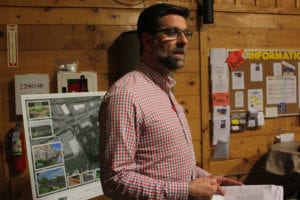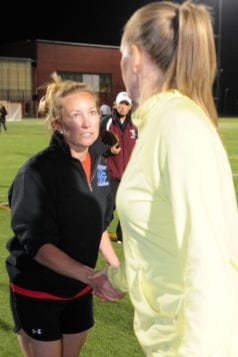A long-vacant property next to King Kullen in Mount Sinai could be a go-to living destination for young professionals and college graduates in the near future.
According to a real estate investors group’s preliminary proposal made during the recent Mount Sinai Civic Association meeting, they want to give millennials a suburban place to stay and a sense of community.
“A lot of our young people leave Long Island because they can’t afford to stay here,” said Michael Russo, an architect working with the Nassau-based group Basser-Kaufman, to residents at the Heritage Center June 5. “Mount Sinai is a desirable place to live [and] we’ve put a lot of thought into making it work for millennials.”

An expansive, 140-rental unit community is envisioned in the early stages of the concept, gearing toward those in their mid to late 20s, to occupy the rear portion on the nearly 35 acres of unused land along Nesconset Highway.
The proposed site would include potential retail developments such as Trader Joe’s, other commercial buildings, an open green space for public use, a community center with fitness and yoga rooms for residents and several amenities to attract a younger demographic, such as bicycle racks, dog-walk areas and electric car-charging stations. Valet trash services would also be available to eliminate large, noisy trucks.
Rental prices for one-bedroom and two-bedroom units would range between $1,900 and $2,200 a month, according to the group’s legal representative — priced lower than many competitive apartments in the area, such as the New Village apartments in Patchogue, to make it manageable for young people to live in the region.
“Having this for younger people in your district is an advantage,” said Steven Losquadro, a lawyer speaking on behalf of Basser-Kaufman. “It’s a bridge to home ownership, which is ideally what you would want. You don’t want them going out of state, you want to have them here where they grew up.”
The executive board of the civic association, including President Ann Becker and Vice President Brad Arrington, had met previously with the developers to discuss the draft proposal and ensure its concept fit the vision of the community.
“Without risking discrimination, how will you restrict it to millennials?” asked Mount Sinai resident and board of education member Edward Law.

While the speakers said they couldn’t legally limit occupancy to just young people, their intention is to specifically market it to that age group through advertising locations and methods.
“What’s the projected time line?” was another question that was asked.
Russo said the construction would take 18 months to two years, but added it could take years to get the project approved.
Mount Sinai resident Peter Pranzo voiced his concern about the already increasing number of students in the district, he said, as a result of young parents in the housing development. He said he’s afraid of the financial pressure it could put on schools to pay additional costs for more new students.
“I’m against it,” he said of the proposal. “There’s no way we can sustain 60, 70 or 100 more children in our area.”
Arrington argued the opposite.
“Class sizes are shrinking quite a bit,” he said. “A lot of our enrollment is actually down in younger grades. These aren’t going to be terribly large apartments, so by the time that child enrolls in school it’s pretty likely the parents are going to move out and buy a house.”
Losquadro agreed, insisting the development would be geared toward young professionals and there wouldn’t be a substantial influx of children.
When a resident suggested the possibility of those behind the proposal abandoning it in favor of solely retail space, Becker spoke up.

“These gentlemen were very open with us and we were open with them,” Becker told the crowd at the end of the meeting. “We don’t want a lot of things — big box stores or gas stations — and they’re trying, and working with the town. They’re completely transparent. This is the first presentation to the community, no plans have been submitted and nothing has gone through any process of change. This is just step one. We’re very interested in hearing your response.”
For more than a decade, the town has worked alongside many developers with plans to build within the empty lot — everything from commercial buildings to retirement communities to community-oriented gathering spaces and clock towers — all of which fizzled out due to inflated visions or conflicting desires of residents.
In the last few months, Steven Kaufman and Marc Kemp of the investors group took control of the project, determined to give the community what they felt it wanted, and ask for input before anything is approved or built.
“Right now, I think I’m for it,” Mount Sinai resident Monica Stone said after the meeting. “I think we need to be open to ideas like this … We don’t want it to become an industrial business area, and it sounds to me like what the developers are proposing is a good balance.”












































